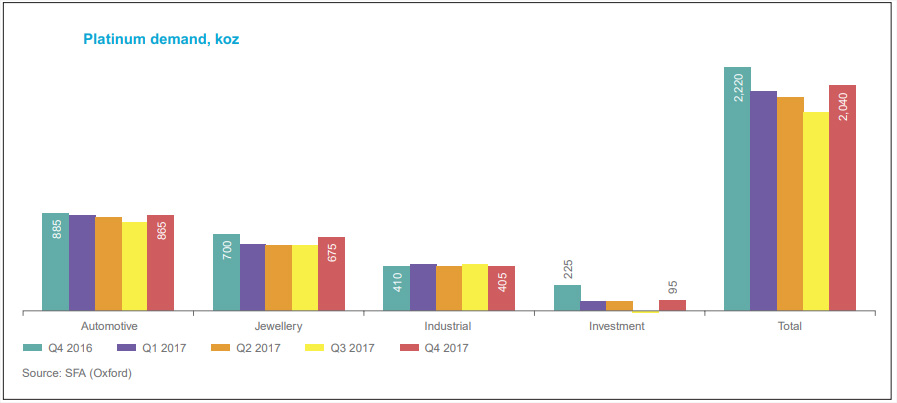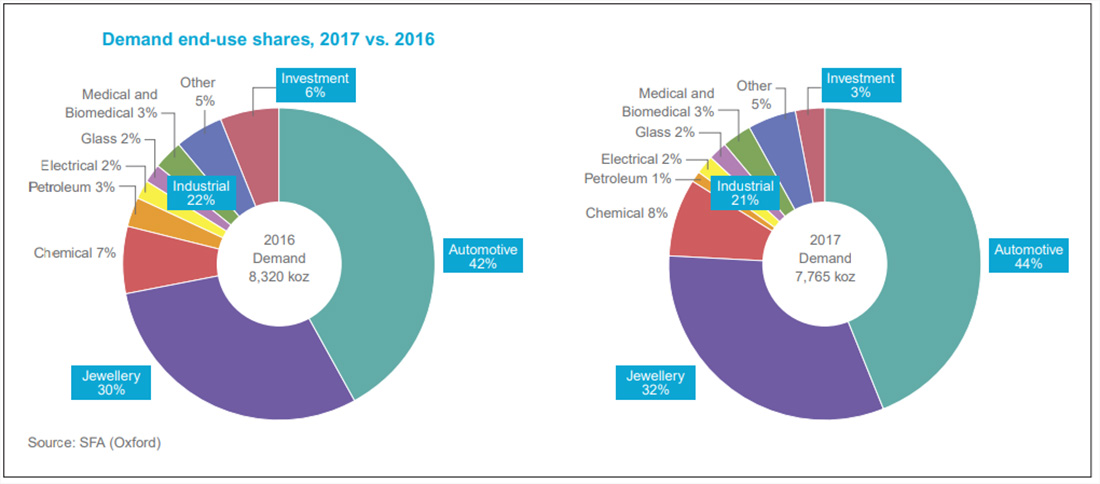Global platinum jewellery demand slipped in 2017 as gains in other regions struggled to offset a decline in China, the World Platinum Investment Council (WPIC), a research firm backed by mining companies, said in its latest Platinum Quarterly report. Worldwide platinum jewellery demand fell 2% yearon-year to 2,460 koz in 2017, it noted.
WPIC estimated India’s platinum jewellery demand for 2017 at 175 koz, an increase of 21% over 2016. WPIC said that it had rebased its India demand to a lower level from its previous forecast of 305 koz for 2017 after it received new information from metal suppliers and organisations in the retail sector.
“The growth (in India) has been revised down slightly for 2017, but was still very strong at 21% as 2016 was a difficult year with strikes and demonetisation hindering fabricator purchases, which resulted in destocking as retail demand continued to grow,” WPIC said.
In China, the report stated, younger generations are changing traditional purchasing habits and are spending more on technology and experiences to the detriment of jewellery sales. “Additionally, the number of marriages in 2017 continued the decline which started in 2013, as the population of marrying age shrinks and a lower proportion of them are getting married,” it noted.
WPIC revealed that white gold, or “k-gold” in China, continues to pose a threat to platinum as the lower gold content and easier manufacturing make it cheaper to buy despite the high gold price. However, there were positive signs in 2017 from retail demand, with China’s overall retail sales increasing by 1.9%, and in the second half of the year retailers reported an expansion in jewellery sales, although gold benefited more than platinum.
Challenging Q4
Global platinum jewellery consumption decreased 4% year-on-year to 675 koz in the fourth quarter of 2017, but was up 15% quarter-on-quarter.
“India is still adjusting to the Goods and Services Tax (GST), and although major jewellery chains have been able to adapt since the introduction in July, smaller producers are struggling to cope with the system. The end of 2017 saw reports that the processing of tax refund applications was very slow, with many jewellers struggling with working capital and losing out on business opportunities,” WPIC said.
China’s platinum jewellery demand decreased by 8% year-on-year in the fourth quarter, in line with the annual change, it noted. After a relatively weak third quarter in 2017 in terms of fabricator demand, restocking picked up in the final quarter following Golden Week sales, a strong retail performance in the third quarter and in preparation for the Chinese New Year.
Trading of platinum on the Shanghai Gold Exchange was down 10% in the fourth quarter while imports going directly to jewellery companies increased by 8%. Although China’s national retail sales declined 1.9% year-on-year, it seems jewellery might have outperformed, contrary to the trend of recent years, as China’s largest jeweller Chow Tai Fook reported same-store sales growth of 5% in the fourth quarter of 2017, with market share shifting towards gem-set pieces (which include platinum settings and jewellery) in Hong Kong but towards gold in Mainland China. Luk Fook reported 1% growth in sales, with gem-set pieces outperforming gold jewellery.
In Japan, fourth-quarter retail sales of platinum jewellery were down year-onyear owing to a decline in the popularity of platinum chains, which have an above average per piece platinum content, in favour of gold and white gold chains.

Outlook for 2018
Worldwide platinum jewellery demand in 2018 is estimated to be 45 koz (+2%) higher than in 2017 at 2,505 koz after four years of decline. This is mainly due to a marginal growth forecast for China in 2018 along with growth trends in other regions, WPIC said.
WPIC specified that Indian producers and consumers have mostly moved past the impacts of demonetisation and the changes of the GST. “The anti-money laundering legislation posed a threat to demand growth, but was repealed in the fourth quarter of 2017. The main lingering headache is the implementation of the state services to support the GST, but if the government can solve those communication issues then there is little to prevent 2018 from being a strong year for sales,” it stated.
The report added that China is seeing a recovery in market conditions: GDP growth accelerated in 2017 for the first time since 2010 and spending in third-tier cities is increasing. Jewellers have been targeting their marketing at lower tier cities and expanding their presence there, and major Chinese jewellers increased the number of points of sale last year. Within the jewellery sector optimism is high that 2017 was the bottom of the curve. There are concerns that the low platinum price has negatively affected its perception as a premium metal but efforts by jewellers to make jewellery a more personal, emotional and design focused purchase, in order to attract millennials, mean that jewellery is increasingly priced per piece rather than by metal content. While the bridal market is expected to decline again next year, self-purchasing by women has demonstrated the potential to replace some of this demand.
Japan is expected to see little change in jewellery demand in 2018, but strong economic growth forecasts in the US and Europe, alongside a reasonably favourable platinum price, should support growth in those regions, it said.
Indian producers and consumers have mostly moved past the impacts of demonetisation and the changes of the GST… The main lingering headache is the implementation of the state services to support the GST.”

